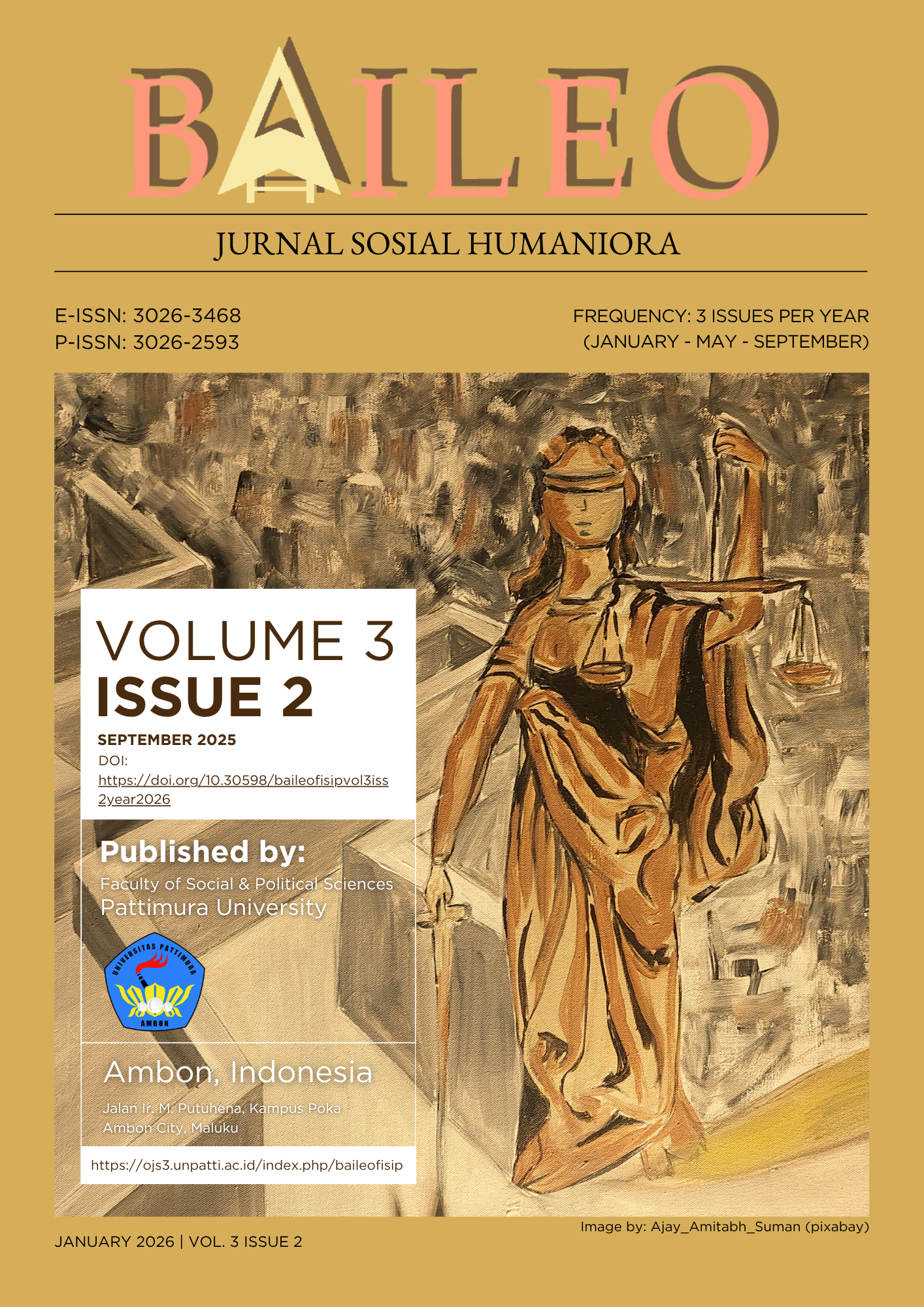Bridging Spatial Inequality Through Infrastructure: A Sociological Study on Sustainable Development of Small Island Communities in Eastern Indonesia
Abstract
Spatial inequality between central regions and small islands in Eastern Indonesia shows that infrastructure development remains uneven and socially unjust. This study aims to analyze the role of infrastructure in reducing spatial and social inequality in small island regions, identify sociocultural dynamics influencing infrastructure acceptance and sustainability, and formulate a community-based model of sustainable development. Using a qualitative sociological approach, the study employs SWOT and Participatory Planning Analyses to examine strengths, weaknesses, opportunities, and threats from a local-social perspective, combined with Participatory Rural Appraisal (PRA) through in-depth interviews, field observations, and focus group discussions in Metimiarang Island. Findings indicate that infrastructure serves as a social integrator that enhances access to basic services, economic opportunities, and social cohesion in peripheral areas. Yet, weak governance, fragmented stakeholder coordination, and low community participation hinder effectiveness. Sustainable programs are those integrating local wisdom and social institutions, notably community-based 3R (reduce, reuse, recycle) systems. The study’s novelty lies in introducing a socio-infrastructural bridging framework, positioning infrastructure as a social bridge linking marginalized regions to development centers. Theoretically, this research expands development sociology by embedding spatial and ecological dimensions, reinforcing the relevance of the sociology of infrastructure within the Sustainable Development Goals, particularly Goals 9 (Industry, Innovation, and Infrastructure) and 11 (Sustainable Cities and Communities).
Downloads
References
Addie, J.-P. D. (2022). The Times of Splintering Urbanism. Journal of Urban Technology, 29(1), 109–116. https://doi.org/10.1080/10630732.2021.2001716
Afdhal, A. (2024). Women’s Political Communication in Maluku: Opportunities, Challenges, and Socio-Cultural Dynamics. Konsensus : Jurnal Ilmu Pertahanan, Hukum Dan Ilmu Komunikasi, 1(5), 81–97. https://doi.org/10.62383/konsensus.v1i5.395
Bierbaum, A. H., Karner, A., & Barajas, J. M. (2021). Toward Mobility Justice. Journal of the American Planning Association, 87(2), 197–210. https://doi.org/10.1080/01944363.2020.1803104
Blok, A. (2022). Eventful Infrastructures. In The Routledge Handbook of Social Change (pp. 347–360). Routledge. https://doi.org/10.4324/9781351261562-33
Büscher, B., & Fletcher, R. (2019). Towards Convivial Conservation. Conservation and Society, 17(3), 283. https://doi.org/10.4103/cs.cs_19_75
Chen, M., Zhang, T., Chu, Q., Xie, L., Liu, J., Tansuchat, R., & Geng, Y. (2023). Convergence Analysis of Inclusive Green Growth in China Based on the Spatial Correlation Network. Sustainability, 15(16), 12344. https://doi.org/10.3390/su151612344
Corchia, L., & Borghini, A. (2025). Infrastructure as a sociological category: Concept, applications, and paradigmatic turns? Journal of Classical Sociology, 25(2), 123–151. https://doi.org/10.1177/1468795X251327051
Davidson, J. S. (2021). Opposition to privatized infrastructure in Indonesia. Review of International Political Economy, 28(1), 128–151. https://doi.org/10.1080/09692290.2019.1668461
de Zwart, P. (2022). Inequality in late colonial Indonesia: new evidence on regional differences. Cliometrica, 16(1), 175–211. https://doi.org/10.1007/s11698-020-00220-3
Ghifara, A. S., Iman, A. N., Wardhana, A. K., Rusgianto, S., & Ratnasari, R. T. (2022). The Effect of Economic Growth, Government Spending, and Human Development Index toward Inequality of Income Distribution in the Metropolitan Cities in Indonesia. Daengku: Journal of Humanities and Social Sciences Innovation, 2(4), 529–536. https://doi.org/10.35877/454RI.daengku1092
Goel, R. K., Yadav, C. S., & Vishnoi, S. (2021). Self-sustainable smart cities: Socio-spatial society using participative bottom-up and cognitive top-down approach. Cities, 118(4), 103370. https://doi.org/10.1016/j.cities.2021.103370
Graham, S., & Marvin, S. (2022). Splintering Urbanism at 20 and the “Infrastructural Turn.” Journal of Urban Technology, 29(1), 169–175. https://doi.org/10.1080/10630732.2021.2005934
Haxhija, S., Duran-Rodas, D., Larriva, M. T. B., & Wulfhorst, G. (2024). A Mobility Justice Framework to prioritize areas for mobility interventions. Research in Transportation Business & Management, 56(2), 101192. https://doi.org/10.1016/j.rtbm.2024.101192
He, Y., Li, Z., Wang, X., & Chen, X. (2025). Government investment, human capital flow, and urban innovation: Evidence from smart city construction in China. International Review of Financial Analysis, 99(4), 103916. https://doi.org/10.1016/j.irfa.2025.103916
Hornok, C., & Raeskyesa, D. G. S. (2024). Economic zones and local income inequality: Evidence from Indonesia. The Journal of Economic Inequality, 22(1), 69–100. https://doi.org/10.1007/s10888-023-09581-x
Kartiasih, F., Djalal Nachrowi, N., Wisana, I. D. G. K., & Handayani, D. (2023). Inequalities of Indonesia’s regional digital development and its association with socioeconomic characteristics: a spatial and multivariate analysis. Information Technology for Development, 29(2–3), 299–328. https://doi.org/10.1080/02681102.2022.2110556
Kartiasih, F., Nachrowi, N. D., Wisana, I. D. G. K., & Handayani, D. (2023). Towards the quest to reduce income inequality in Indonesia: Is there a synergy between ICT and the informal sector? Cogent Economics & Finance, 11(2), 1771. https://doi.org/10.1080/23322039.2023.2241771
Khajuria, A., Atienza, V. A., Chavanich, S., Henning, W., Islam, I., Kral, U., Liu, M., Liu, X., Murthy, I. K., Oyedotun, T. D. T., Verma, P., Xu, G., Zeng, X., & Li, J. (2022). Accelerating circular economy solutions to achieve the 2030 agenda for sustainable development goals. Circular Economy, 1(1), 100001. https:/doi.org/10.1016/j.cec.2022.100001
Laksana, S., & Rahmat, A. M. Al. (2022). How to Cope With Strategic Infrastructure Disparities in West Java? (A Post-Pandemic Economic Recovery Analysis ). The Journal of Indonesia Sustainable Development Planning, 3(3), 222–245. https://doi.org/10.46456/jisdep.v3i3.353
Leal Filho, W., Frankenberger, F., Salvia, A. L., Azeiteiro, U., Alves, F., Castro, P., Will, M., Platje, J., Lovren, V. O., Brandli, L., Price, E., Doni, F., Mifsud, M., & Ávila, L. V. (2021). A framework for the implementation of the Sustainable Development Goals in university programmes. Journal of Cleaner Production, 299(2), 126915. https:/doi.org/10.1016/j.jclepro.2021.126915
Litaay, S. C. H., Manuputty, F. M. L., Afdhal, A., & Makaruku, N. D. (2025). Local Culture-Based Education in the Hidden Curriculum: A Strategy for Fostering Tolerance and Peace in Maluku Secondary Schools. Society, 13(1), 192–207. https://doi.org/10.33019/society.v13i1.777
Lu, H., Zhao, P., Hu, H., Zeng, L., Wu, K. S., & Lv, D. (2022). Transport infrastructure and urban-rural income disparity: A municipal-level analysis in China. Journal of Transport Geography, 99(2), 103292. https://doi.org/10.1016/j.jtrangeo.2022.103292
Lu, S., Fang, G., & Zhao, M. (2023). Towards Inclusive Growth: Perspective of Regional Spatial Correlation Network in China. Sustainability, 15(7), 5725. https://doi.org/10.3390/su15075725
Mahaarcha, D., & Sirisunhirun, S. (2023). Social capital and farmers’ participation in multi-level irrigation governance in Thailand. Heliyon, 9(8), e18793. https://doi.org/10.1016/j.heliyon.2023.e18793
Manuputty, F., Litaay, S. C. H., Afdhal, A., & Makaruku, N. D. (2025). Pendidikan Keluarga Berbasis Budaya Lokal: Studi Sosiologi pada Masyarakat Negeri Hukurila, Kecamatan Leitimur Selatan. Jurnal Mahasiswa BK An-Nur : Berbeda, Bermakna, Mulia, 10(3), 208. https://doi.org/10.31602/jmbkan.v10i3.16452
Miranti, R. C. (2021). Is regional poverty converging across Indonesian districts? A distribution dynamics and spatial econometric approach. Asia-Pacific Journal of Regional Science, 5(3), 851–883. https://doi.org/10.1007/s41685-021-00199-3
Mohd Arifin, S. R. (2018). Ethical Considerations in Qualitative Study. International Journal of Care Scholars, 1(2), 30–33. https://doi.org/10.31436/ijcs.v1i2.82
Moldicz, C. (2025). Building Fast and Cheap Infrastructure in an Island Nation. In C. Moldicz (Ed.), Indonesia’s Economy After Joko Widodo (pp. 75–100). Springer Nature Switzerland. https://doi.org/10.1007/978-3-031-87120-7_4
Muskat, B., Matthias, M., & and Zehrer, A. (2018). Qualitative interpretive mobile ethnography. Anatolia, 29(1), 98–107. https://doi.org/10.1080/13032917.2017.1396482
Nawir, D., Bakri, M. D., & Syarif, I. A. (2023). Central government role in road infrastructure development and economic growth in the form of future study: the case of Indonesia. City, Territory and Architecture, 10(1), 12. https://doi.org/10.1186/s40410-022-00188-9
Ritter, C. S. (2022). Rethinking digital ethnography: A qualitative approach to understanding interfaces. Qualitative Research, 22(6), 916–932. https://doi.org/10.1177/14687941211000540
S. Siatan, M., Gustiyana, S., & Nurfitriani, S. (2024). Infrastructure Development and Regional Disparities. 1st International Conference on Islamic Economics, Business Development and Studies, 799–806. https://doi.org/10.18502/kss.v9i16.16289
Santos-Marquez, F., Gunawan, A. B., & Mendez, C. (2022). Regional income disparities, distributional convergence, and spatial effects: evidence from Indonesian regions 2010–2017. GeoJournal, 87(3), 2373–2391. https://doi.org/10.1007/s10708-021-10377-7
Stacey, N., Gibson, E., Loneragan, N. R., Warren, C., Wiryawan, B., Adhuri, D. S., Steenbergen, D. J., & Fitriana, R. (2021). Developing sustainable small-scale fisheries livelihoods in Indonesia: Trends, enabling and constraining factors, and future opportunities. Marine Policy, 132(5), 104654. https://doi.org/10.1016/j.marpol.2021.104654
Syam, I. H. (2025). Comparative study of infrastructure development and its impact on human development index: Economic and geographical insights. Economic Military and Geographically Business Review, 2(2), 73–88. https://doi.org/10.61511/emagrap.v2i2.2025.1518
Teniwut, W. A., Hasyim, C. L., & Pentury, F. (2022). Towards smart government for sustainable fisheries and marine development: An intelligent web-based support system approach in small islands. Marine Policy, 143(2), 105158. https://doi.org/10.1016/j.marpol.2022.105158
Wahyuni, R. N. T., Ikhsan, M., Damayanti, A., & Khoirunurrofik, K. (2022). Inter-District Road Infrastructure and Spatial Inequality in Rural Indonesia. Economies, 10(9), 229. https://doi.org/10.3390/economies10090229
Wiratama, B. F., Kurniawan, R., Mulyanto, Isnaeni, M. A., Sumargo, B., & Gio, P. U. (2023). Measuring the physical infrastructure development as poverty reduction program in Kalimantan, Indonesia. Cities, 141(3), 104515. https://doi.org/10.1016/j.cities.2023.104515
Xiao, H., & Hao, S. (2023). Public participation in infrastructure projects: an integrative review and prospects for the future research. Engineering, Construction and Architectural Management, 30(2), 456–477. https://doi.org/10.1108/ECAM-06-2021-0495
Xu, Y., & Zhu, S. (2024). Transport Infrastructure, Intra-Regional Inequality and Urban-Rural Divide: Evidence From China’s High-Speed Rail Construction. International Regional Science Review, 47(3), 378–406. https://doi.org/10.1177/01600176231177672
Copyright (c) 2026 Ony Frengky Rumihin

This work is licensed under a Creative Commons Attribution 4.0 International License.




